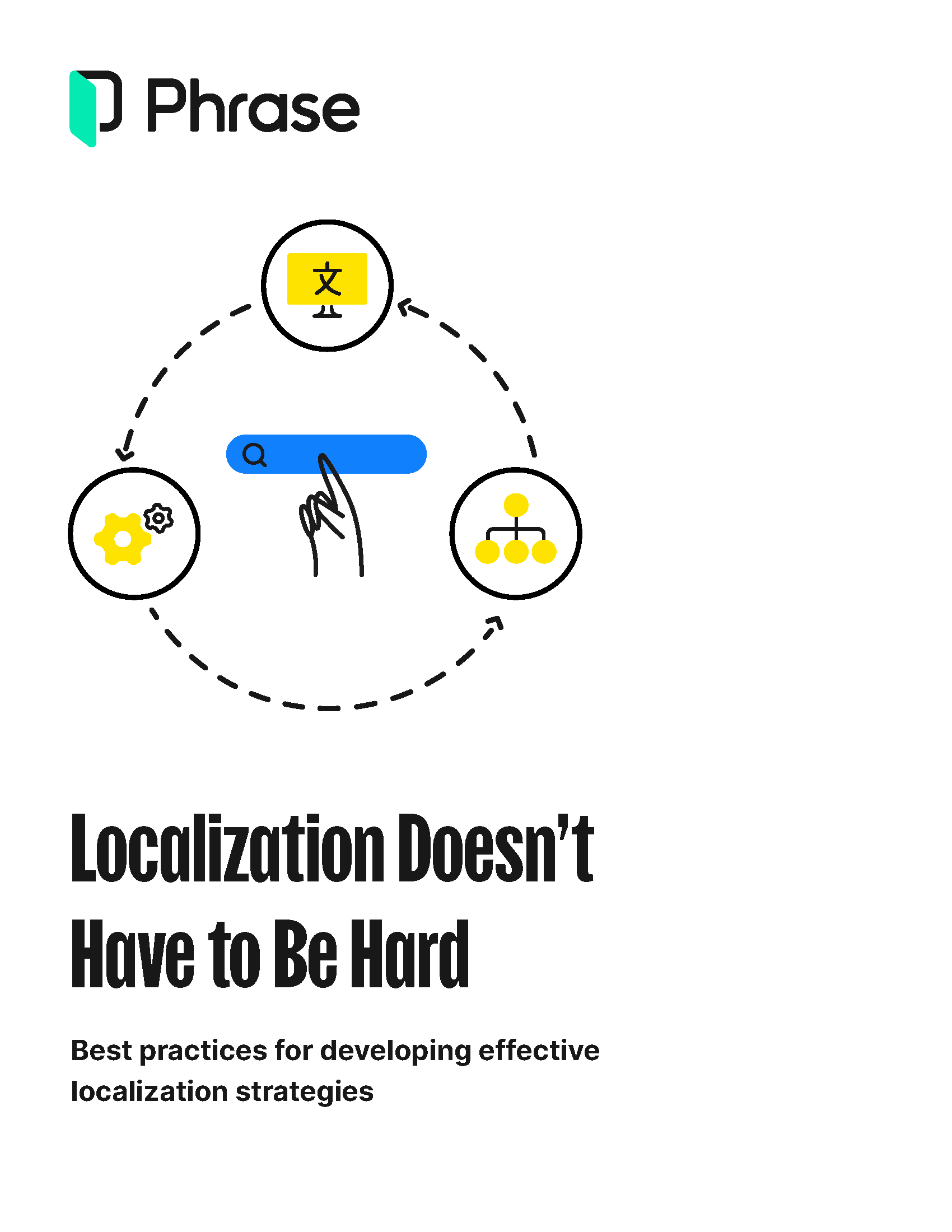Localization strategy
How to Choose the Right Localization Services

Companies on track for global growth often face language as a major barrier to market entry. While English is technically the number one language on the internet, it represents only 25% of the world’s internet users. What is more interesting is that unlike English, user numbers for languages such as Chinese, Spanish, or Arabic are growing at unprecedented rates.
For a product or service to earn trust and attract buyers across markets, it doesn’t only need to “speak” their language but also have a local look and feel. The adaptation process required to go beyond mere translation, known as localization, involves designing a whole new user experience that takes into account local expectations, currencies, legal requirements, and more.
Every company pursuing a serious global expansion strategy needs professional localization services that are powered by modern localization technology. To help you better evaluate which localization services may make sense for your business needs, this guide will walk you through everything you need to know about localization services as a lever for growth.
What are localization services?
Localization is the process of adapting a product to suit the language and culture of a target market. When implemented properly, it enables the product to connect with customers in a language and format that feels native to them. Besides translating written content from one language into another, localization has a great deal to do with:
- Adapting written content to local preferences and tastes
- Modifying layout and design to fit the translated text
- Choosing the right images for the target market
- Displaying the correct currency and units of measure
- Using local formats for addresses, phone numbers, or dates
- Complying with legal requirements and local regulations, etc.
Localization services are used to adapt products to the culture and language of customers in different target markets. Aiming to make a product look and feel local, localization services providers include teams of translators, developers, designers, local marketing experts, linguists, localization or translation project managers, etc. In an ideal scenario, they all work together on a cloud-based localization platform, regardless of time zones, locations, and backgrounds.
Localization services are the result of a team effort in which different experts contribute their knowledge and expertise to help you achieve your localization goals. These experts include:
- Linguists (translators, editors, proofreaders, etc.) translate and revise your content into the target language, making sure that it reads naturally, conforms to localization best practices, and appeals to cultural preferences. They also perform linguistic testing to check that the localized content works as intended.
- Developers and software localization engineers prepare your product or website at the code level to ensure that it’s compatible with localization. This includes making sure that there are no hard-coded strings, that text can expand or contract without breaking the layout, etc. Once localization is complete, they also integrate the translated content into the product or website to ensure that it fits into the functionality as intended.
- UX and UI designers create localization-friendly designs that can accommodate longer or shorter text strings, left-to-right or right-to-left writing, etc. Moreover, they adapt layouts, designs, and user interface elements to the specificities of the target market and culture. Designers also adapt your visuals (images, videos, graphs, etc.) to better resonate with the target audience and ensure a consistent look and feel across cultures.
- Localization or translation project managers lead the localization process from start to finish for each iteration, coordinating the work of all localization experts, setting localization objectives, adapting to feedback and changes, managing deadlines and budget, etc. They centralize all project-related information in a localization platform and report on progress, ensuring that the localization process is as smooth and efficient as possible.
- Local marketing experts help you understand your target market, research localization trends and cultural preferences, and develop a localization strategy that will enable you to achieve your business goals. For example, local SEO experts help you adapt your website and content to rank higher in local search results.

Free download
Best practices for developing effective localization strategies
Explore how to tackle localization management efficiently and engage customers across the globe in their native languages and local experiences.
When should I use localization services?
Whether you’re just starting to explore new markets or you have already built up a customer base in multiple countries, localization services can take your business further. More specifically, localization services can be used for:
- Entering new markets: Focusing on localization from the get-go will help you step into new markets with a product or service that’s relevant to local users, establishing trust with potential customers from day one.
- Expanding your business in existing markets: Even after you’ve entered new markets and started building up a customer base, localization should still be on your mind. By continuously adapting your product to the ever-changing needs of local users, you can stay ahead of the competition and keep your business growing.
- Boosting engagement and loyalty: Localization is not only about expanding your reach to new markets but also about keeping your existing customers happy to prevent them from churning. A fully local experience will make users feel valued and encourage them to keep coming back for more.
- Reinforcing a brand identity that stays consistent across markets: While the needs of each market are unique, localization should not sacrifice the consistency of your brand identity and messaging. Good localization services will help you preserve your brand’s unique voice while still making sure that it comes across as natural to local users.
The use cases for localization services are endless, with new opportunities emerging all the time as the world becomes increasingly globalized. If done right, localization can help you tap into new revenue streams, better engage your customers, and build a strong foundation for long-term success in any market, whether you want to:
- Release a local version of your software in a target market.
- Offer a mobile app to users in a specific country or region.
- Publish a multilingual website.
- Bring out a video game for a global user base.
- Launch promotional campaigns across channels and markets.
- Provide assistance in different languages for customers worldwide to make better use of your product or service.
- Verify the accuracy, consistency, and overall quality of a localized product before launching it in a new market, etc.
What localization services do I need?
Depending on the product or service you offer, as well as your localization goals and budget, you may need different localization services. From software localization to video game localization, the options are very diverse. Here are some of the most common localization services:
Software localization services
Software localization is the process of customizing the look and feel of a software application—for example, an app or a web-based tool—to match the preferences of users in a specific target market. The aim is to meet the linguistic, cultural, and legal expectations and requirements of the local market while still preserving the software’s core functionality and features.
This includes adapting the user interface (UI) of your software product, user experience (UX) elements—such as menus, labels, buttons, and error messages—written content, and all accompanying assets into the target language. It also entails making sure that the software functions properly in the target market in terms of locally preferred hardware, currency, payment methods and delivery options, and so on.
App localization services
This type of localization is very similar to software localization but with a focus on mobile apps. In addition to translating and adapting the app’s UI and UX, it also includes optimizing the app for different devices, local standards, and user expectations in the target market.
App localization aims to amplify the app’s coverage and discoverability, download and adoption rates, as well as ROI by making it as relevant and user-friendly as possible for a local audience. During the localization process, app developers and localization experts will work together to ensure that every asset in the app—including in-app copy, app store descriptions, metadata, visual elements, and more—conforms to the cultural norms, preferences, and expectations of the target market.
Website localization services
Website localization is the process of adapting a website—including the written content, visual elements, user experience, and functionality—to meet the expectations of users in a specific location. People around the world are far more likely to buy from a website that’s available in their own language and relevant to their local context.
This type of localization also normally involves SEO localization, which is the process of optimizing a website for better discoverability in different regions and markets. This includes researching and incorporating relevant local keywords, as well as adapting the website’s meta data, hosting, and other technical aspects. Prior internationalization (i18n) is what often makes website localization much easier and more effective, and post-deployment testing should also come as part of the process to make sure that the localized website is up to par.
Video game localization services
Amazing graphics, sound, and gameplay aren’t enough to make a video game successful in today’s global market. In order to reach and engage players with the widest possible audience, video game localization has become essential. The aim is to make users feel like the game was developed specifically for them, in their language and cultural context.
During localization, you can adapt all the content in the game—from the storyline and character development to the UI and in-game copy—to better resonate with players in different markets. It’s essential to find linguists who are also gamers, as they’ll be able to adapt the game in a way that captures the spirit and feel of the original while still making it relevant to a local audience.
Marketing localization services
No matter how good your product or service might be, it won’t sell itself—especially if you’re targeting international markets where language barriers might be an issue. This is where marketing localization comes in, as it’s all about adapting your marketing strategy, assets—including your website, social media presence, product descriptions, and advertising campaigns—, and processes to better suit the needs of a specific target market.
Marketing localization can help you boost your brand’s discoverability, reputation, and bottom line by making sure that you develop the right messaging and tone for each market you’re targeting. When you consider that emotional connection—something that speaking your customers’ language can help you create—is twice as valuable as customer satisfaction in terms of competitive advantage, marketing localization starts to look like a very attractive proposition.
Technical localization services
Knowledge bases, user manuals, help files, software documentation, FAQs, how-to videos, and other types of technical content need to be localization-friendly in order to serve a global audience. This means that they need to be easy to understand—the technical aspects as well as the language—and relevant to the needs of users in different markets, while still being accurate in terms of the product or service they’re describing.
Technical localization is usually part of wider multilingual customer support efforts. When you provide your users with accurate technical translation of key documentation or how-to videos, self-service becomes an option and support requests start to go down. Moreover, by localizing this type of content, you can make sure that everyone understands how to use your product or service, which can help you avoid customer churn.
Localization testing services
Localization testing is about making sure that a localized product or service works as intended and meets the needs of users in a specific market. This type of testing goes beyond checking for typos and grammar mistakes, as it also includes functional testing and usability testing to detect and fix any localization-related issues prior to release.
Localization testing is essential for ensuring a positive user experience in the target market. Just like testing the original product or service is essential for finding and fixing any bugs before release, localization testing should also come as part of the process to verify that the localized version is equally polished. It should work as expected, meet the cultural and technical expectations of local users, and check out from a linguistic standpoint.
What makes professional localization services?
The human element is key for localization, but it’s not the only thing that you need to consider when looking for localization services. Professional localization providers also need to have the right tools and processes in place to ensure quality, consistency, and efficiency throughout the localization process.
A combination of technology and localization expertise is what gives localization providers the ability to scale their operations and handle large localization projects without compromising on quality. The best and most professional localization services providers use a mix of localization tools and processes to streamline their workflows and manage their localization projects more effectively.
The least resource-intensive localization solution is to use localization software—e.g., a translation management system or localization platform—that integrates with your existing tech stack and that supports the localization processes from start to finish. This way, you don’t have to worry about integrating multiple tools or dealing with silos of content in different formats. Application programming interfaces (APIs) are what make this possible, as they enable localization tools to communicate with each other and exchange data in a structured way.
No localization service can be called professional if it doesn’t rely on modern technology to some extent. For example, localization providers that use localization platforms can take advantage of localization automation to automatically extract content from source files, speed up the process with the aid of AI-driven machine translation, programmatically insert translated content back into the file, and much more.
Human expertise and modern localization tools working together are what enable localization providers to offer high-quality, scalable localization services—and it’s precisely what you should look for when choosing a localization provider for your business.
What are some key features of localization software?
When looking for localization software, there are certain key features that you should consider to ensure that the tool can support, automate, and potentially scale—if needed—your localization processes. Here are some of the most important localization software features to keep in mind:
- Cloud-based access: Cloud-based localization tools are more flexible than on-premise tools, as you can access your files and information from anywhere and on any device. Moreover, they don’t require any installation or set up.
- Flexibility: Look for a tool that lets you easily add or remove users and features as your localization needs change. Changing from one localization project to another should be a seamless experience where you can quickly adapt the tool to your new localization needs—in terms of number of users, file formats, and more.
- API support and integrations: APIs are what enable localization tools to talk to your existing tech stack and infrastructure, and exchange data in a structured way. This allows you to automate tasks such as content extraction, translation, and delivery back into your content management system (CMS) or other tools.
- Translation memory: Translation memory is a feature that stores all your translated content in a database. This way, you can reuse previously translated content—especially in the case of identical or near-identical content—and save time and money on your localization projects. A translation memory also allows translators to perform a “concordance search” to find previously translated terms or phrases, even if they don’t exactly match the content they’re working on.
- Simple search: A localization tool should offer a simple search feature that allows you to quickly find the files or content you’re looking for—even if you don’t know the exact file name. This can be a lifesaver when working on large localization projects with hundreds or thousands of files or words—both for translators and localization managers.
- User-friendly user interface: Look for a tool with an intuitive interface that’s easy to navigate and use and doesn’t require much training to get started. Your whole team, regardless of technical ability, should be able to use the tool without having to spend hours learning how it works.
- Good documentation and support: If software issues do ever arise, it’s important that the localization tool you’re using offers good documentation to help you troubleshoot problems. In addition, a localization software provider should offer reliable customer support in case you need help with anything—this can be the difference between missing a deadline and successfully completing a localization project.
- A centralized working environment: Everyone involved in a localization project—translators, localization managers, developers, testers, and more—should be able to access the localization tool and all the relevant project files in one place. This way, everyone is always on the same page and working with the most up-to-date versions of files.
- Possibility to customize: Localization software should be customizable and offer a certain degree of flexibility to meet the specific needs of your localization projects. Whether you need to add support for files in a certain format or want to create a custom workflow, your localization tool should be able to accommodate.
- Scalability: Tiered, subscription-based pricing models that consider usage, volume of translated text, or number of language combinations to determine monthly costs aren’t ideal, because they don’t offer the flexibility or scalability you need for localization projects. Instead, look for localization software with a pricing model that allows you to use the tool as flexibly as you want without having to worry about overage fees.
What are the benefits of a localization platform?
When comparing the benefits of using a localization platform to doing all the work manually side by side, the differences couldn’t be more striking.
| Why working without a localization platform is painful | How you can excel thanks to a localization solution |
| You have to carry out lengthy and tiring manual work | You can be more efficient through automating recurring tasks |
| There are no useful resources to rely on, such as a translation memory | You can retrieve past work to speed through your projects |
| You’ll have to shift through and fix a ton of human errors and mistakes | You can avert most errors immediately through built-in quality control |
| You need to start each new localization project from scratch | You can exploit your translation memory to accelerate new projects |
| It takes longer to build a product without the use of technology | You can finalize a product more quickly, sometimes, with just a few clicks |
| You need to employ additional tools for delivering different tasks | You can use the same simple platform for various tasks across projects |
| Reporting and monitoring will have to be done manually at every step | You can create reports and check your project status with one click |
How to evaluate and choose the best localization services
The criteria for choosing the best localization services provider should depend on various factors. Your needs might be different from another company’s, so it’s important to think about what’s most important for your localization projects before making a decision.
Some questions you might want to ask yourself include:
- What markets will you be targeting? Some language services providers (LSPs) specialize in certain geographic regions, while others have a more global reach.
- Will your workflow be agile, lean, or traditional? Depending on your localization process, you might need an LSP that’s able to work quickly and adapt to the communication flow of your company.
- How much content do you produce daily, weekly, monthly? It’s not uncommon for an LSP to distribute large volumes of content among several translators to get the job done quickly—which might not be ideal in terms of quality or consistency. Choose an LSP that will be able to strike the right balance between quality and speed for your needs.
- Will you roll-out to all markets at once or take an in-region, phased approach? When more content needs to be ready simultaneously, your LSP will need to manage localization processes and workflows for multiple markets. Look for an LSP that has the appropriate localization technology and processes in place to handle this type of volume.
- Will you need to outsource QA? You might want to consider an LSP that offers built-in quality assurance (QA) from start to finish, which can be especially helpful if you don’t have the internal resources to do it yourself. However, if you already have a QA process in place—e.g., non-domestic speakers checking the localization before it goes live—you might not need this service.
- What file formats do you need localization services for? If you are working with state-of-the-art software and tools, but your localization services provider only accepts older file formats, this will obviously create a disconnect.
- Is your content mostly self-explanatory or highly technical? The in-context translation through automated UI screenshots offered by the best translation management systems (TMS) can help with localization if your content is dense or technical in nature. If this is the case, look for an LSP that has a localization platform with this type of functionality.
- How quickly do you need your provider to turn around localization projects? With smaller providers, you might need to extend your deadline to accommodate their schedules, as they might be resource-strapped. Bigger players can often turn projects around more quickly, but they might not check all your localization boxes.
- What are your plans for scaling? If you plan on frequent updates and new content production, but don’t need high volumes or many language combinations, a medium-sized LSP might suffice. On the other hand, if you constantly produce big localization projects that need to be completed quickly and flawlessly, you’ll need a larger LSP with the technology, platform, and team to get the job done.
- How do you define service level? You need to consider what will happen if any potential localization problems arise. Make sure the LSP you’re working with has a clear understanding of your requirements and can provide support if necessary. A legal agreement that outlines both parties’ responsibilities is often a good idea.
Localization services can help you take your business global
When done right, localization services can help you go from a domestic market player to a global one. But with the vast array of localization providers and technology solutions available, it can be tough to figure out where to start—or even what localization services you need.
To get the most bang for your buck, make sure that you choose the type of service that works best for your specific content and context, the technology that will save you time and money in the long run, and the provider that offers the right mix of quality, speed, and service level for your needs.
Speak with an expert
Want to learn how our solutions can help you unlock global opportunity? We’d be happy to show you around the Phrase Localization Platform and answer any questions you may have.





